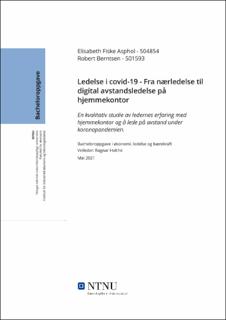| dc.description.abstract | Bakgrunn: Bakgrunn for oppgaven er motivasjon for å finne ut hvordan ledere har opplevd å arbeide under et uvanlig år med coronaviruset, som har endret hverdagen på svært mange.
Hensikt: Undersøke opplevelsen av å lede på avstand i en pandemi.
Metode: Kvalitativ undersøkelse med 9 semistrukturerte intervju
Resultater: Generelt viser det at organisasjonene har lykkes i overgangen fra nærledelse til avstandsledelse. Dette gjennom gode ledere og medarbeidere som følte en “dugnad følelse, skikkelig brette opp armene og ta i ett tak, dette skal vi klare og at vi skal vise at det går ant å jobbe hjemmefra også” (R7). Etterhvert som pandemien utviklet seg til å vare lengre enn først antatt og hvor vi fortsatt er i pandemien har blitt en tretthetsfølelse og utmattelse fra og ikke kunne reise på kontoret og snakke face-to-face med sine medarbeidere.
Konklusjon: Ledelse er krevende å gjennomføre ideelt slik situasjonen er nå. Da det kan være vanskelig å se medarbeidere, vite hvordan de føler seg og terskelen for å ta kontakt har økt. Hjemmekontor er kommet for å bli,og i framtiden vil det bli mer fleksibel hybridform på ledelse og arbeidsmiljø.
Ord/Begrep: Vi har benyttet ulike ord som har tilsvarende samme betydning, dette for å skape en variasjon i språket. Et eksempel på dette er; Covid-19, korona, koronaviruset, koronapandemien, koronasituasjonen, koronakrisen, pandemien. | |
| dc.description.abstract | Background: The background for our motivation is to find out about how leaders have experienced the working condition in an unusual year, with the current pandemic and the covid-19 virus. This virus has changed the day-to-day work which before the pandemic used to be in the office, and during these times have transformed into a work-from-home experience whereas many hadn’t done this before.
Intention: The intentions of this paper is to find out about the experiences if leading during a pandemic.
Method: Qualitative research method, with 9 semi structured interviews
Result: Generally the results show that several organisations have been successful in the transition from close management to distance management. This has been accomplished through leaders and co-workers that “Had a volunteer feeling, to fold up your arms and grab a hold of the situation. The feeling was that this was something we would manage, that we were gonna show that working from home also is doable.” (R7, translated to English). The pandemic lasted longer than anyone had participated, and we are still living in the pandemic and under the covid-19 virus. This has led to a lot of people feeling tired, and exhausted from not being able to travel to the offices and talking face-to-face with their co-workers.
Conclusion: Leadership is a demanding task to be able to do ideally during these times, as you can’t physically see your coworkers, as someone might not feel okay, and don’t have the courage to reach out for help. It seems like a version of a hybrid-office has come to stay, as more and more leaders and businesses can see that the working from home method has worked out rather well, more so than many had initially thought.
Words/terms: We have used different terms which have the same meaning throughout the text, this has been done to get a variation in the language, some examples of this is: Covid-19, Coronavirus, Coronapandemic, Corona Situation, Coronaemergency, and Pandemic. | |
